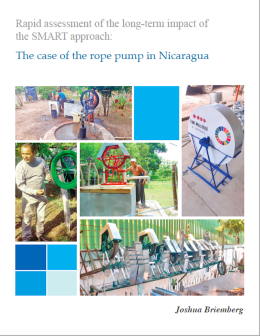RWSN Library

Author
J. Briemberg
Year of Publishing
2022
Publisher
SMART Centre Nicaragua
Institution
Centro de Tecnologías SMART de Agua, Saneamiento e Higiene – SMART Centre Nicaragua.
Rapid assessment of the long-term impact of the SMART approach
The case of the rope pump in Nicaragua
Description:
The rope pump was introduced in Nicaragua starting in 1983 as an alternative technology for improving water supply particularly in rural communities. After almost a decade of improvements more than 1,500 pumps had been installed by 1991 and by 1995 accepted by the government’s rural water division1 as one of the standard hand pumps for rural water supply. The recently revised Potable Water Supply System Design Standards continue to include manual rope pumps in a section of borehole wells up to 50 meters deep and a productivity no less than 0.30 litres per second.
The rope pump should be considered to an emblematic SMARTech: Simple, Market-based, Affordable, Repairable Technology. Moreover, the process of its introduction, development/scaling up, and evolution in the Nicaraguan context established the conceptual basis for the SMART approach motivated the future development of SMART Centres to implement this approach, first in eight African countries and since 2017 in Nicaragua. The SMART approach combines the concept of SMARTechs with a focus on building supply and value chains and accelerating self-supply. The assessment over time of the reach and impact of the rope pump in Nicaragua, is thus highly informative for other efforts to accelerate self-supply and the cost-effective sustainable universalization of access to WASH.
Bibliographical Information:
J. Briemberg (2022) Rapid assessment of the long-term impact of the SMART approach. The case of the rope pump in Nicaragua , Centro de Tecnologías SMART de Agua, Saneamiento e Higiene – SMART Centre Nicaragua. , SMART Centre Nicaragua , Nicaragua
More Information
DOWNLOADS (34)
The-SMART-Approach-The-Case-of-the-Rope-Pump-in-Nicaragua-FINAL
 Google Übersetzer
Google Übersetzer
